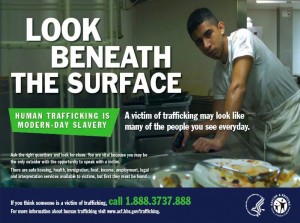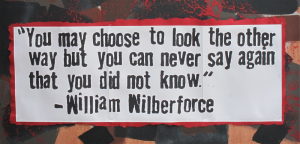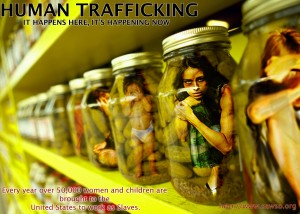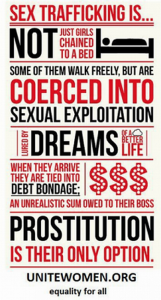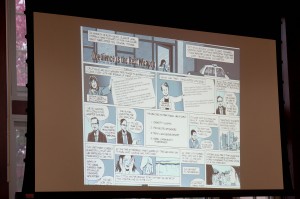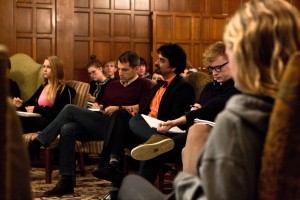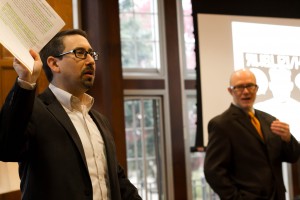A group of three students from Professor Krain’s FYS: Human Rights and Wrongs–Sarah, Katie, and Sammi–worked to compile a detailed website pertaining to human trafficking. The sight introduces readers to the concepts of human rights and walks them through the issue of human rights: what constitutes human trafficking, what are the signs, human trafficking in Ohio, and what everyone can do to make a difference in the face of this global problem. Check it out and send the link on to your families and friends as well–spread the word.
Slavery Is Alive and Kicking by Zane Thornburg
Human trafficking is often overlooked as an issue that exists today. Many people not only believe that it doesn’t exist anymore, but that it hasn’t existed since the US Civil War. I was one of those people until recently. Through the class I am in, I have learned that it is still very real today.
Through a lecture with Anthony Talbott, I not only learned that it still exists, but that it is everywhere. Human trafficking is not just an issue in countries with a history of neglecting human rights, it is an issue on everyone’s home front. I found this out when Anthony Talbott showed a map of the counties in the state of Ohio and my home county was highlighted showing that it had had several human trafficking convictions recently. Human trafficking was never an issue I had ever imagined existing where I am from, but it is.
I would highly suggest to any person who does not know about human rights issues going on around their home to do some basic research to learn what is going on in their area and/or how they can help to stop the issue or raise awareness. Most important when trying to address issues of as human trafficking or other human rights issues and violations, is to remember that certain goods and services available to you may be produced with the exploitation of another person and the violation of their human rights. So, if you are interested in joining in the fight for human rights, you can start small with your own life and research where the goods and services you consume come from and make changes to only purchase goods and services that aren’t produced by violating human rights.
The Variety of Human Trafficking by Mackenzie Kellar
As I listened to Anthony Talbott talk on Monday evening, I was surprised to learn of some of his main points. I think people have different definitions of human trafficking, but Talbott’s definition was chilling and straightforward: “the buying and selling of human beings.” Many have heard of this, but they are unaware of how often and how close to home these horrible atrocities actually occur. Many, too, are unaware of the many types of things that are classified as human trafficking. Forced labor, sex trafficking, bonded labor, debt bondage among migrant laborers, involuntary domestic servitude, forced child labor, child soldiers, and child sex trafficking are the universal types of human trafficking. He also brought to our attention that a human need not be physically transported for it to be considered human trafficking; trafficking can happen in a victim’s own backyard. I think this is something many people don’t consider.
Talbott stated that, although mostly women and children fall victim to trafficking, males do as well. Many people are forced, tricked, or even threatened into situations. They are often lured in with the promise of work opportunities, false romantic involvement, offers in exchange for sex, or even by being kidnapped. This, to me, is sickening; human beings taking advantage of fellow human beings. This goes to show how many see others as lesser than them, and that “slavery” is still an issue in today’s society. Many tend to think that these things don’t occur anymore, or that they only occur in other countries, but Talbott went on to show us that trafficking is even happening here in Ohio. As horrible as it is, there are not many ways to completely abolish these atrocities, at least not right away. Activists are raising awareness and calling people to action, but it will take more than just that. We learned that trafficking brings in about $32 billion annually, and I was dumbfounded. I had no idea that this was still such a huge issue and part of today’s society. I think Talbott did a great job of informing all of us on such a huge topic, and he got his point across very well.
I also really enjoyed hearing from Sara McKinnon on Thursday as she shared a chapter from her book, “Standing in Her Shoes: Transnational Politics in U.S. Asylum Policy for Chines Opposing Population Control.” It was very interesting to hear her view on this topic. She covered things I wasn’t even aware of and raised many questions. It was also really neat that we were some of the first people who had the privilege of hearing an excerpt from her book. I think all of the speakers did a very nice job of getting their messages across and getting all of our minds thinking of ways we can help with these huge issues. I really enjoyed learning, more in depth, about human trafficking and beyond.
Perspectives on Borderlands by Sidney Irias
Nowadays, societies live by stereotypes, labeling people by what they think is acceptable, even happening without people knowing they are judging others. What the speakers explained to us about Borderlands was eye opener. Borderlands contains powerful, real life stories about human trafficking. I believe all these comics were amazing because they not only contain a story but also drawings which allow us to see what really happens without photoshop, frames, or a clear face of the character. Pain and frustration describe almost every story and the person involved in it.
We usually believe that people who do not have a decent job chose that life, but is that true? This brief book makes us see things from another perspective, the victim’s perspective. These people suffered abuse and know know the suffering of long term psychological damage. It is so hard to imagine someone in this position without asking why it happened to them. Truth is there is no answer for that, there is no one reason. These were all examples of people who looked further a better future but ended up trapped in human trafficking. Unfortunately, many will never understand their stories and will simply judge them for the life they lead without knowing their story.
Everybody has a story to tell in this life, whether is a fortunate or an unlucky one. Getting to know a person begins with a single question. There are millions of people going through the misfortune of human trafficking in the world. We can help reduce human trafficking. One of the forms to do so is to educate everyone as much as possible. Human trafficking is one of the worst things people can do. It leaves a person damaged after everything, sometimes without hope or motivation for the future. Thanks to Dan Archer and Donna Trusova we know a little more about human trafficking, how to be aware of it, and how it works.
The Necessity of Critical Consumption by Nicole West
Being college students, many of us can agree that the balances in our bank accounts are pretty limited. And as a result we’re always looking to save some money. We’ve all purchased a cheap item at Walmart or a dollar store and have been thrilled at the savings. But many of us don’t stop to think about the real cost behind it. Would you support the exploitation and abuse of a child through the forced labor industry? Or even the exploitation of adults? A majority of us would adamantly say no, we agree that it’s a morally corrupt practice. But we often fail to realize that we are doing just that when we purchase cheap goods. These cheap products are typically made in sweat shops by men, women, and children who have fallen victim to human trafficking. Not exactly what you thought when you saw that price tag, right?
I would never say that I support such an industry, but Anthony Talbott’s talk made me realize that I have indeed done exactly that. Many of us have by being uninformed consumers. This isn’t some small industry, either. Approximately 21 million men, women, and children have been trafficked and are victims of forced labor.1 Contrary to popular belief, many of these people are educated. They just find themselves in difficult times and are often lured in by the pretense of a stable job and necessities.2 They want to provide a better life for themselves or their families and so they accept the offer. They are often transported locally, nationally, or even internationally. When they arrive, despite the promises, they typically perform very tedious work for little to no pay under very poor conditions. Traffickers then use violence, coercion, debt bondage, and other tactics to keep victims from leaving.2 Traffickers are only in the business because they can make a large profit. With the global population increase, they can now purchase workers at very low costs. They then make a profit when the products that cost them virtually nothing to make are sold in the global marketplace. Forced labor provides an illegal yearly profit of approximately $150 billion.1 The profit is the main reason why traffickers are in the business, not because they personally have anything against the victims. Instead, they see an economic opportunity and thus find people who can easily be exploited. This is a human rights issue and a global problem. There are efforts in many countries to help end the trafficking taking place around the world, but unfortunately the victims are the ones being criminalized instead of the traffickers.
Anthony Talbott’s talk really opened my eyes on the topic of human trafficking, the modern day form of slavery. Sadly, this is not the only from of trafficking, but it was the one that I was least aware of. Talbott suggested being an informed buyer as a means to combat the issue. By knowing where our products are coming from we can avoid purchasing those made by forced laborers. An alternative option to purchasing more expensive products that were not made by forced laborers is to buy cheaper secondhand goods so at least workers aren’t re-exploited. By just taking a few minutes to educate ourselves on where our merchandise is coming from we can make a difference.
- “Forced Labour, Human Trafficking and Slavery.” International Labour Organization. Web. 26 Oct. 2014. <http://www.ilo.org/global/topics/forced-labour/lang–en/index.htm>
- “Human Trafficking.” Polaris. Web. 27 Oct. 2014. <http://www.polarisproject.org/human-trafficking/overview>
Human Trafficking: We Are the Demand by Sarah Huffman
During this past week I had the opportunity to hear from several people, including graphic journalist Dan Archer and professor and activist Anthony Tallbot. And while we discussed many useful facts, statistics, and issues throughout the week, I started to discover something more and more unsettling as the discussion progressed: these perpetrators, ring leaders, and pimps are not manifestations of evil and wickedness. They all don’t share some monstrous face. They are, in other words, normal, every-day looking people. The act, therefore, of human trafficking isn’t due to irrational wantonness and psychopathy, but instead to simple capitalization by these ring leaders off of a profitable industry. And—like any industry—when there is a demand, there will be a supply to meet it. We are that demand.
We are the demand whether we realize it or not. The issue is that we, including many living in Ohio, tend to avoid thinking about where our products come from. Even though we know that the sources of many of our goods are questionable, we usually laugh it off and attribute it to the lazy and over-indulgent nature often associated with the American stereotype. However, by doing this, we lighten and ignore the very serious origin of how our goods are made. Although what I have discussed so far mainly pertains to labor trafficking, it can also apply to sex trafficking. There is a demand for that as well, and the stereotypes and jokes we make about sex trafficking do not help either. Through our actions and inactions we have effectively normalized and routinized human trafficking, which is modern-day slavery.
Photographing Modern Day Slavery (TEDx video)
When watching this video, I swelled on questions about how her photographs and narration vary from the approach taken by Dan Archer, as they addressed very similar stories. Do you prefer one over the other? Is one more effective than another? What are the benefits and limitations of each approach? Just some thoughts for your Sunday afternoon.
“Photographer Lisa Kristine has been traveling the world for the last 2 years documenting the problem of modern day slavery. Some 27 million people are thought to be enslaved worldwide even though human slavery is illegal. From backbreaking labor in brick factories and underground mines, to sex slavery, to textile mills and farms, Lisa tells the story of the people featured in her heart-braking photographs.
In a world where the items being produced have far more value than the people producing them, and women and children are terribly objectified, slavery is sadly a persistent horror that requires worldwide attention. Please watch this TedX presentation and support the work of FreeTheSlaves.net.”
Sex Trafficking and Violence in Ohio by Dorie Schram
Anthony Talbott’s very educational talk on human trafficking on Monday night really opened my eyes. He made me realize that human trafficking is not just something that you hear about happening in distant places, but something that happens right here in Ohio. Some facts he stated were surprising and outraging to me. Toledo is the #4 city in arrests and investigations related to child sex trafficking. 1,078 American-born Ohio youth have been trafficked into sex trade in the past year. In a broader sense, 100,000 children are exploited for commercial sex in the United States.
This is a very serious issue as human trafficking severely traumatizes its victims. Many times they not only lack access to showers and enough food and water, but also are often handled roughly. There are three types of sex trafficking in the U.S.: residential/underground brothel settings, escort services, and pimp-controlled prostitution. Most victims of sex trafficking were vulnerable and somehow tricked into the business, whether it was through false romantic involvement or the offer of food, shelter, and a seemingly legitimate job. Because they go willingly and are from vulnerable backgrounds, sometimes they can be stuck in these bad situations for many years.
I worked at a shelter for teenage victims of domestic violence during my senior year of high school and was able to see first hand how much of an impact ongoing violence can have on people’s lives. Activism and advocacy are very important in helping end this serious human rights violation. We need to get active and make a difference for those who lack the information or tools to change their circumstance themselves. To help, you can contact groups like Abolition Ohio and join in their work to end human trafficking.
Borderlands in Images
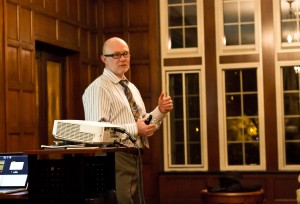
Anthony Talbott speaks about the state of human trafficking around the world and specifically in Ohio.
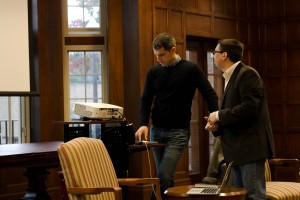
Dan Archer presented briefly about his process and the utility of multimedia for creative and informative journalism.

Sarah McKinnon read an excerpt of a chapter from her new book, entitled “Standing in her Shoes: Transnational Politics in US Asylum Policy for Chinese Opposing Population Control.”
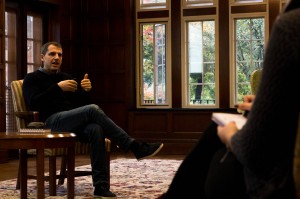
Dan Archer (pictured) and Professor Talbott engaged in a lively discussion, answering students’ questions about activism and human trafficking, particularly emphasizing what is being done and what actions students can take.
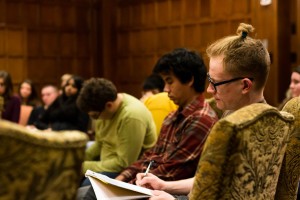
Students were engaged with Professor McKinnon’s presentation, drawing parallels with what they had learned about policies for immigration and asylum for victims of trafficking.
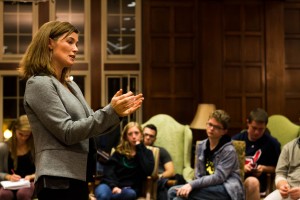
Much of Professor McKinnon’s lecture focused on the gendering of asylum cases, as well as the legal evolution of recognition of forced sterilization and abortion as legal basis for asylum claims.

Professor Moledina led the charge, and used Storify to unite all the tweets as well as additional images and videos to provide a unitary narrative of the events.
Myths and Misconceptions of Human Trafficking by Geoffrey Carney-Knisely
The extent to which human trafficking is prevalent and takes place in plain sight is alarming. People assume that people who are trafficked for sex are adults simply taken and work the streets. This idea is overly simplistic. The average child who is taken for sex trafficking is between the ages of 12 and 14. Not only that, but one in three runaway teens will be lured towards prostitution after leaving home. (More stats can be found here).
It is also necessary to dispel that myth that only females are trafficked, men are trafficked as well (even for sex). Another misconception is that only foreigners are trafficked, but this can also happen to native United States citizens. Human trafficking has fallen off the radar as a political issue for many people. It is interesting to consider that in the United States we have a victim-centric view of trafficking; we easily overlook the traffickers or even the “Johns” who create the demand for it.
What is even more alarming is the fact that many of us have contributed to demand for human labor trafficking; take, for example, the shirts available at Wal-Mart for $5 or goods created in sweatshops for corporations such as Nike. There are easy ways to avoid human trafficking goods, such as by buying fair trade products, and if people really need to purchase cheap goods, thrift shops or used clothing stores can be great alternatives to reduce the demand for these goods. Human trafficking is a prevalent global issue, and if we remain unaware consumers, we can easily perpetuate demand for such goods; but if we remain aware, we can help to reduce the demand for trafficking.
